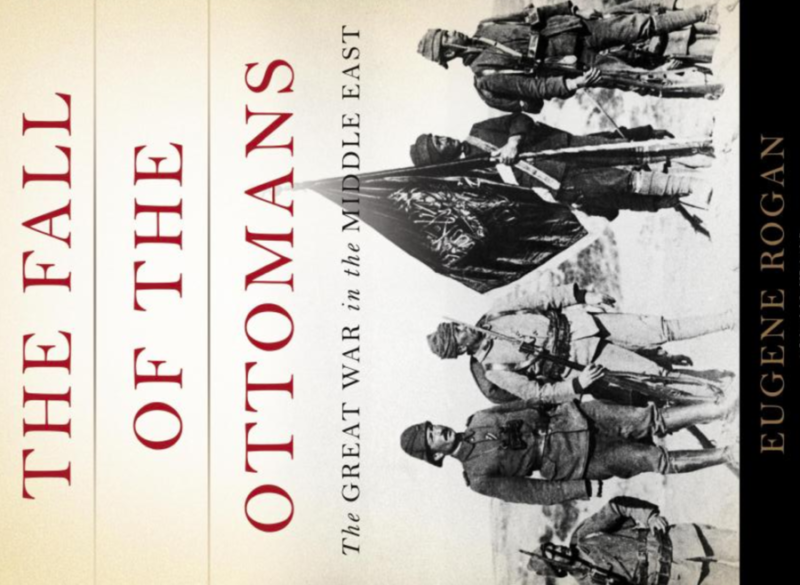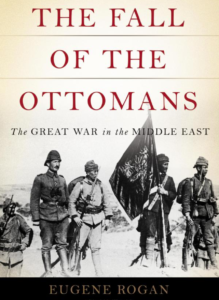
Eugene Rogan, The Fall of the Ottomans: The Great War in the Middle East. (NY: Basic Books 2016) 512. Pages. Hardcover, $23.00
Reviewed by David Kelly
In his book, Eugene Rogan argues that now is the time to restore the Ottoman front to its rightful place in the transnational history of both World War I and the development of the modern Middle East. This would help, he argues, the scholarly community to understand the root causes of the problems in the modern Middle East. Rogan’s account argues furthermore that the Ottoman entry into the World War I turned a European conflict into a ‘world war.’ The book acts as an excellent survey of not only the collapse of the Ottoman Empire but how that collapse shaped the Middle East as it is seen today. By examining the rise of Turkish nationalism, Ottoman victories and failures in the first World War, the Armenian ‘genocide,’ and the impact of the Arab Revolt, Rogan’s book presents a thorough look at how a non-European power influenced the modern twentieth century.
The Ottoman decline had been in the works for decades before the outbreak of war in Europe. Rogan explains how both European and Russian expansion saw the Ottomans lose nearly two-fifths of its territory and about twenty percent of its population. The rise of Turkish nationalism in the form of the Young Turks was one of the most important reasons for understanding how the Ottomans got swept up into the war. A counter-revolution against the Young Turks exposed Turkish-Armenian antagonism that had been in development for decades. Violent Armenian conflicts that began in earnest in 1894 were peppered throughout the history of the Ottoman decline. Rogan draws a distinction between what he calls the ‘massacres’ of 1894-1896 and the ‘genocide’ of 1914-1915. Turkish ultra-nationalism also began to alienate Arabs after 1913 when the Young Turks assumed power. The seeds for collapse had been planted and the group most responsible, the Young Turks and their ultra-nationalist agenda, dictated its course.
“The Fall of the Ottomans reads like a narrative of the Empire before, during, and after World War I. After setting the stage of Ottomans experiences in the five years preceding the War, Rogan then takes the reader on a whirlwind tour of political, social and military history of the Ottoman Empire”
The Fall of the Ottomans reads like a narrative of the Empire before, during, and after World War I. After setting the stage of Ottomans experiences in the five years preceding the War, Rogan then takes the reader on a whirlwind tour of political, social and military history of the Ottoman Empire. Chapter 3 examines how Germany seemingly manipulated the Ottomans to open a second front to relieve pressure in Europe; Chapter 5 explores the running theme of uniting Muslims globally to fight for the Ottomans via a jihad and its ultimate failure to launch, and the early causation of, what Rogan deemed in Chapter 7, the Armenian ‘genocide.’ Chapter 3 sadly allows for a Euro-centric view that strips the Ottomans’ agency – that they were only involved in the War due to the Germans. Rogan’s argument in  Chapter 7 is that deportation of Armenians was what the Ottomans seemed to have focused the majority of their internal efforts on. The same chapter examines in detail how the Young Turks were responsible for the massacre of between 800,000 and 1.5 million Armenians. Rogan writes that in the spring of 1915, the Young Turks “declared the entire Ottoman Armenian population a dangerous fifth column” and average citizens were mobilized to assist in their annihilation (160). Rogan notes also, however, that this political directive was also due in part to growing violence espoused by the Armenians against the Ottomans in the hope of gaining intervention from Europe for the establishment of a separate Armenian state.
Chapter 7 is that deportation of Armenians was what the Ottomans seemed to have focused the majority of their internal efforts on. The same chapter examines in detail how the Young Turks were responsible for the massacre of between 800,000 and 1.5 million Armenians. Rogan writes that in the spring of 1915, the Young Turks “declared the entire Ottoman Armenian population a dangerous fifth column” and average citizens were mobilized to assist in their annihilation (160). Rogan notes also, however, that this political directive was also due in part to growing violence espoused by the Armenians against the Ottomans in the hope of gaining intervention from Europe for the establishment of a separate Armenian state.
The brief look at the Ottoman victory at Gallipoli in Chapter 8 provides another strong example for Rogan’s effort to develop a non-European account of the War. His account is in contradiction to the orientalist point-of-view that saw an Allied defeat at Gallipoli instead of an Ottoman victory. Semantics aside, the Ottomans actually lost more men than the combined forces of ANZAC did, but the western narrative saw Gallipoli as the greatest defeat for the Allies, not the triumphant Ottoman stand that Rogan describes. This is a key strength to Rogan’s argument about the importance of this subject matter and how to understand it historically. The victory at Gallipoli freed up thousands of Ottoman soldiers and that created a larger Ottoman military presence in the Middle East. To defeat the Ottomans, the British would make promises to the Arabs for post-war independence. Those promises and the utter failure for them to materialize after the war fed into a continued distrust and hatred for foreign interlopers in Arab countries and as Rogan argues, the process shaped the modern Middle East today.
Rogan argue in Chapter 9 that the invasion of Mesopotamia acted as the culmination of Arab/Ottoman hostility. In May, 1915, towns and villages of the Middle Euphrates “rose in rebellions” that ran for two years in southern Iraq. This, and other actions by the Ottomans against local populations, Rogan argues, directly led to the Arab Revolt albeit with British assistance. As the threat of jihad still lingered, the British allied themselves with the Sharif of Mecca to discourage colonial Muslims from fighting against the allies. Rogan insightfully writes that “the link between the Hashemite revolt in Arabia and the British campaign in Palestine” would ultimately cause the downfall of the Ottoman Empire and conversely decide the fate of the region (309). When Mecca, Baghdad, and Jerusalem fell to the British, the Ottoman call for jihad would no longer be a factor.
“According to Rogan, the Ottoman Empire fell apart more as a result of the draconian peace terms than due to the enormity of their defeat. The conclusion signals to the reader that the book is intended to provide a political history of the Empire during the War rather than a comprehensive military history.”
According to Rogan, the Ottoman Empire fell apart more as a result of the draconian peace terms than due to the enormity of their defeat. The conclusion signals to the reader that the book is intended to provide a political history of the Empire during the War rather than a comprehensive military history. By 1922, the Ottoman sultanate was abolished. Rogan argues that even though the War had ended in the Middle East, foreign and European domination in that region had not come to an end, nor had European political domination ended in the Middle East as the Balfour Declaration created the Arab/Jewish conflict. The Declaration encouraged Jewish immigration and from 1919 to1921over 18,500 “Zionist immigrants flocked to Palestinian shores.”
“While Rogan’s work does not completely explore every different facet of the Ottoman Empire’s journey into and in World War I, the main contribution of The Fall of Ottomans is to expose the reader to all of the different moving parts of the Ottoman Empire before, during, and after the War.”While Rogan’s work does not completely explore every different facet of the Ottoman Empire’s journey into and in World War I, the main contribution of The Fall of Ottomans is to expose the reader to all of the different moving parts of the Ottoman Empire before, during, and after the War. This exposure can only lead to further research in the topics and events that Rogan discussed. Numerous books have been written in western languages on those different aspects, all mainly from a European point-of-view, so Rogan’s work acts as an introductory piece on both the decline of the Ottoman Empire, its role in the War, and the lasting effects that the Empire’s collapse had on the modern Middle East from an Ottoman-centric angle. The Fall of the Ottomans is potentially a great read for the novice, but expert-scholars on the subject may find relatively few new data and insight in it about Ottoman collapse. Despite this, the significance of the book cannot be understated and it is a must read for anyone looking to embark on a journey that helps understand The Middle East and the conflicts that seem to define it.

